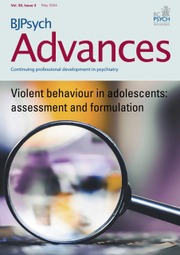No CrossRef data available.
Article contents
The Autistic Spectrum: remembering the influence of Dr Lorna Wing
Published online by Cambridge University Press: 26 June 2025
Summary
The Autistic Spectrum, published almost 30 years ago, remains an important text for all those who work with autistic individuals. This brief article highlights the significant contribution of Lorna Wing to how we view autism, including the observation that many of the issues being highlighted today regarding the appropriate management of autistic individuals are not new and can be found in the thoughts of Dr Wing.
Information
- Type
- Memory Lane
- Information
- Copyright
- © The Author(s), 2025. Published by Cambridge University Press on behalf of Royal College of Psychiatrists
References
American Psychiatric Association (2013) Diagnostic and Statistical Manual of Mental Disorders (5th edn) (DSM-5). APA Publishing.Google Scholar
Beadle-Brown, J, Mills, R (2018) Understanding and Responding to Autism: The SPELL Framework (2nd edn). Pavilion Publishing and Media.Google Scholar
Criminal Justice Joint Inspection (2021) Neurodiversity in the Criminal Justice System: A Review of the Evidence. CJJI.Google Scholar
de Giambattista, C, Ventura, P, Trerotoli, P, et al (2019) Subtyping the autism spectrum disorder: comparison of children with high functioning autism and Asperger syndrome. Journal of Autism and Developmental Disorders, 49: 138–50.10.1007/s10803-018-3689-4CrossRefGoogle ScholarPubMed
HM Government (2021) The National Strategy for Autistic Children, Young People and Adults: 2021 to 2026. HM Government.Google Scholar
Singer, J (1999) Why can’t you be normal for once in your life? From a ‘problem with no name’ to the emergence of a new category of difference. In Disability Discourse (eds Corker, M, French, S): 59–67. Open University Press.Google Scholar
Wing, L, Gould, J (1979) Severe impairment of social interaction and associated abnormalities in children: epidemiology and classification. Journal of Autism and Childhood Schizophrenia, 9: 11–29.Google ScholarPubMed
Wing, L (1981) Asperger’s syndrome: a clinical account. Psychological Medicine, 11: 115–29.10.1017/S0033291700053332CrossRefGoogle ScholarPubMed
Wing, L (1996) The Autistic Spectrum: A Guide for Parents and Professionals. Constable.Google Scholar
Wing, L (1997) Asperger’s syndrome: management requires diagnosis. Journal of Forensic Psychiatry, 8: 253–57.10.1080/09585189708412008CrossRefGoogle Scholar
World Health Organization (2021) International Classification of Diseases Eleventh Revision (ICD-11). WHO.Google Scholar



eLetters
No eLetters have been published for this article.